Summary and Schedule

This resource offers a starting point to learn more about the different types of multidimensional media, as well as managing media in a way which promotes the FAIR principles. The resource also introduces the concept of a Virtual Research Environment to support retrieval and curation of multidimensional data for storytelling via interoperable frameworks.
By the end of this session you are expected to be able to:
- Define the different types of multidimensional media.
- Recognise the advantages of delivering and retrieving multidimensional content over the web via URLs and PIDs.
- Reflect on FAIR and CARE principles and their application on digital heritage research data.
- Understand the usefulness of Virtual Research Environments (VRE) and deploy VREs to support retrieval and curation of multidimensional data for storytelling via interoperable frameworks.
| Setup Instructions | Download files required for the lesson | |
| Duration: 00h 00m | 1. Introduction |
What is multidimensional media? What does the FAIR principles refer to? What type of infrastructure are available for collaborative research and using linking multidimensional data over the web? What do I need to do if I want to create stories with my own multidimensional linked data? |
| Duration: 00h 12m | 2. Types of Multidimensional Media | |
| Duration: 03h 42m | 3. Uniform Resource Locators (URLs) | |
| Duration: 03h 54m | 4. Making it FAIR | |
| Duration: 04h 06m | 5. Virtual Research Environment | |
| Duration: 04h 18m | 6. Retrieving and Curating Multidimensional Data | |
| Duration: 04h 25m | 7. Interoperable Frameworks | |
| Duration: 04h 37m | 8. Storytelling with Mutltidimensional Media | |
| Duration: 04h 49m | 9. Links | |
| Duration: 05h 01m | Finish |
The actual schedule may vary slightly depending on the topics and exercises chosen by the instructor.
Data Sets
Please make use of your own data, data downloaded over the web or data produced via other training resources. For this resource you will need access to a web browser and some space in your computer to store the data.
Details
For this lesson, you will need access to some paper and pen.
Access to the Culture Digital Skills Virtual Research Environment D4Science is also required.
If you have not registered, it would be useful to do this before the lesson. For more information, see instructions.
The tutorial is built with The Carpentries Workbench, as part of the training activities of the AHRC-funded network service on Digital Skills in Visual and Material Culture.

